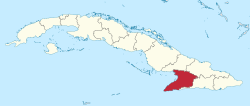Granma Province
Granma is one of the provinces of Cuba. Its capital is Bayamo. Other towns include Manzanillo (a port on the Gulf of Guacanayabo) and Pilón.
Granma Province | |
|---|---|
 Coat of arms | |
 | |
| Country | Cuba |
| Capital | Bayamo |
| Area | |
| • Total | 8,376.79 km2 (3,234.30 sq mi) |
| Population (2010-12-31)[1] | |
| • Total | 835,675 |
| • Density | 100/km2 (260/sq mi) |
| Time zone | UTC-5 (EST) |
| Area code(s) | +53-023 |
History
The province takes its name from the yacht Granma, used by Che Guevara and Fidel Castro to land in Cuba with 82 guerrillas on December 2nd, 1956; until 1976 the area formed part of the larger "Oriente Province". The American who sold the guerillas the secondhand yacht in Mexico apparently had named it "Granma" ("Granma", more usually "Grandma", is an affectionate term for a grandmother) after his grandmother.[2] The name of the vessel became an icon for Cuban communism.
The province is full of reminders of the Cuban Revolution, and of the Cuban Wars of Independence; plaques in the mountain commemorate the 1959 struggle against Fulgencio Batista. Other sites, unmarked, include archaeological digs, the sites of several palenques, and the fortified hamlets of escaped slaves. In 2005 Hurricane Dennis destroyed the site of Castro's headquarters at La Plata. There are numerous abandoned gold, silver, and manganese mine sites.
At the 2018 parliamentary election, Granma was the province with the highest proportion of votes recorded for the full list.[3]
Economy
The majority of the revenue comes from coffee grown in the mountainous regions of the province. During the coffee harvest soldiers may set up roadblocks to ensure the delivery of the coffee to the government and not to the black market.
Municipalities
| Municipality | Population (2004) | Area (km²) | Location | Remarks |
|---|---|---|---|---|
| Bartolomé Masó | 53,024 | 629 | 20.16861°N 76.94250°W | |
| Bayamo | 222,118 | 918 | 20.38167°N 76.64250°W | Provincial capital |
| Buey Arriba | 31,327 | 452 | 20.17361°N 76.74917°W | |
| Campechuela | 46,092 | 577 | 20.23333°N 77.27889°W | |
| Cauto Cristo | 21,159 | 550 | 20.56222°N 76.46944°W | |
| Guisa | 50,923 | 596 | 20.26111°N 76.53806°W | |
| Jiguaní | 60,320 | 646 | 20.37333°N 76.42222°W | |
| Manzanillo | 130,789 | 498 | 20.33972°N 77.10861°W | |
| Media Luna | 35,330 | 376 | 20.14444°N 77.43611°W | |
| Niquero | 41,252 | 582 | 20.04722°N 77.57806°W | |
| Pilón | 29,751 | 462 | 19.90556°N 77.32083°W | |
| Río Cauto | 47,833 | 1,500 | 20.56389°N 76.91722°W | |
| Yara | 59,415 | 576 | 20.27694°N 76.94694°W |
Source: Population from 2004 Census.[4] Area from 1976 municipal re-distribution.[5]
Demographics
In 2004, the province of Granma had a population of 829,333.[4] With a total area of 8,375.49 km2 (3,233.79 sq mi),[6] the province had a population density of 99.0/km2 (256/sq mi).
See also
References
- "Lugar que ocupa el territorio según la superficie y la población" (PDF). Una MIRADA a Cuba (in Spanish). Oficina Nacional de Estadísticas. Cuba. 2010.
- The Independent. At home with Castro: Cuba's 'maximum chief' Archived 2006-08-21 at the Wayback Machine
- https://web.archive.org/web/20180418160711/http://www.granma.cu/file/pdf/2018/03/19/G_2018031905.pdf
- Atenas.cu (2004). "2004 Population trends, by Province and Municipality" (in Spanish). Archived from the original on 2007-09-27. Retrieved 2007-10-02.
- Statoids (July 2003). "Municipios of Cuba". Retrieved 2007-10-06.
- Government of Cuba (2002). "Population by Province" (in Spanish). Retrieved 2007-10-02.